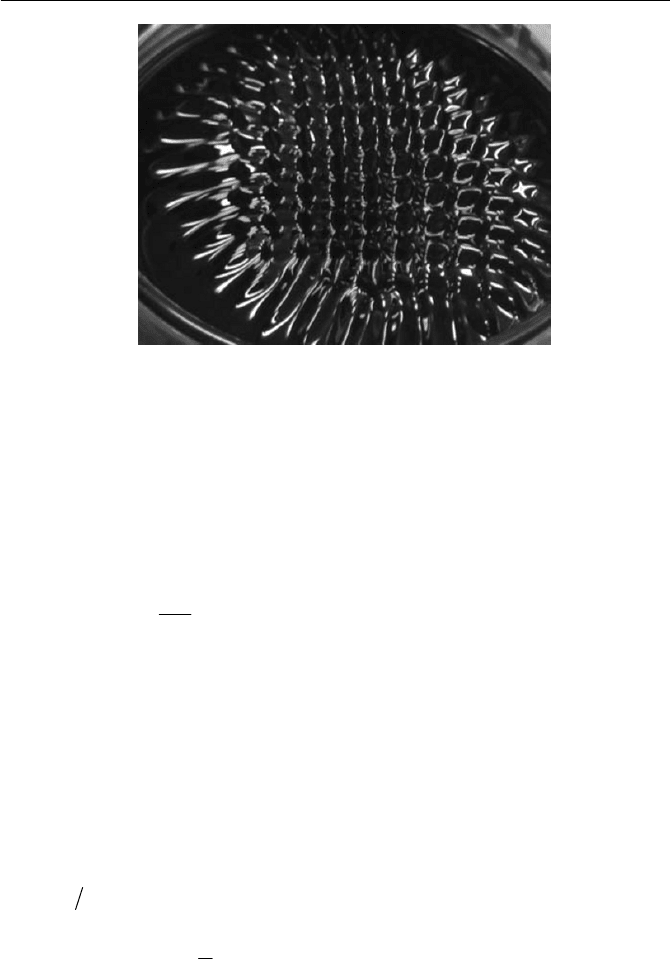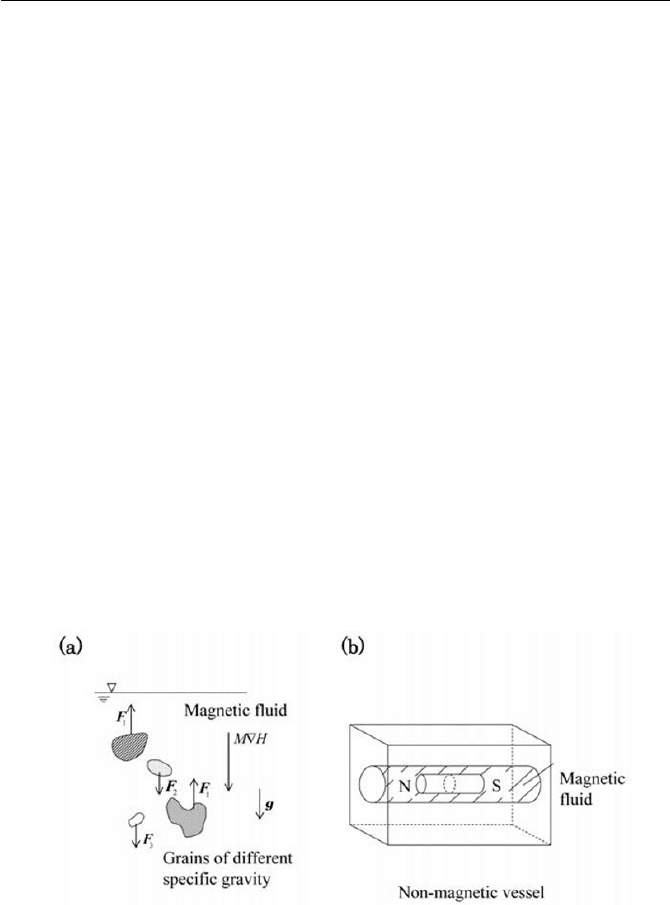Yamaguchi H. Engineering Fluid Mechanics (Fluid Mechanics and Its Applications)
Подождите немного. Документ загружается.


8.2 Ferrohydrodynamic Equations
where
B
W
is the Brownian relaxation of time at a constant. With the aid of
the torque balance equation obtained in Eq. (8.2.25), Eq. (8.2.30) can be
rearranged to yield
HMMMMM
M
uuu
v
B
dt
d
IKW
0
0
6
11
(8.2.31)
The equation derived in Eq. (8.2.31) is the Shliomis magnetic relaxation
equation.
It proves useful to derive an expression of a linear form of Eq. (8.2.31)
and this is done by letting the last quadratic term of the equation to become
H
NmL
vv
HMH
HMM
uu
uu
IK
]
IK
0
0
66
1
2
0
6 H
HNmL
v
HMH uu
IK
]
(8.2.32)
by letting
0
MM be respectively split into parallel and perpendicular
parts to the applied field
H , as
^
`
^
`
2
0
2
0
0
HH
HMMHHMMH
MM
uu
(8.2.33)
Combining Eqs. (8.3.32) and (8.3.33) with Eq. (8.3.30), we have a lin-
earlized magnetization equation to obtain
^`
2
0
22
0
6
11
H
HmLN
HHdt
d
v
BB
HMH
HMHHMMH
M
M
uu
¸
¸
¹
·
¨
¨
©
§
uu
u
IK
]
WW
>@
22
0
11
HH
HMHHMMH
M
uu
u
A
WW
ᇮ
(8.2.34)
where two characteristic relaxation times
ᇮ
W
and
A
W
for respectively paral-
leled and perpendicular contributions are defined where
B
WW
ᇮ
(8.2.35)
and
:
:
:
515

¿
¾
½
¯
®
]]
W
IK
]
WW
L
mHLN
B
v
B
2
1
1
1
6
11
0
so that
A
W
is written as
]
]
W
W
L
B
A
2
2
(8.2.36)
Consequently, for a stationary limit, Eq. (8.3.34) gives a solution in the
linear order
00
MMM u|
A
W
(8.2.37)
Finally, in electromagnetic fields, magnetic fluids are treated as non-
conductive mediums in continuum, and to which Maxwell equations are
written as
0 u
H
(8.2.38)
and for the magnetic induction
0ේ B
(8.2.39)
Equations (8.2.38) and (8.2.39) were already used to reduce ferrohydrody-
namic equations. Note that the induction
B in a continuum has a differ-
ence from the magnetic field (intensity)
H by the magnetization .M This
relation is given in Eq. (8.2.7).
Based on the thought of the intrinsic rotation of magnetic particles, a
phenomenological explanation for the increase of apparent viscosity under
plications for controlling the viscosity of a continuum by external means
are enormous, such as in damping and activating systems in engineering.
Exercise
Exercise 8.2.1 Rosensweig Equation
By considering the linear momentum equation given in Eq. (8.2.17) of
magnetic fluids, show a new set of ferrohydrodynamic equations, assum-
ing that the fluids are incompressible and at a quasi-stationary when the re-
laxation rate is so fast that
M
and H are sensibly collinear, i.e.
H // M
.
:
8 Magnetic Fluid and Flow
applying magnetic field is possible, which is found in Exercise 8.2.2. Ap-
516

Exercise
Also assume that all heat sources and the magnetocaloric effect are identi-
cally neglected in the energy equation.
Ans.
The continuity equation of an incompressible medium is written as
0
u
(1)
under the assumption of
H // M
, that is
gu
u
UKU
HMp
D
t
D
a
2
ේේ
*
(2)
The equation (2) is a so-called Rosensweig equation, first proposed by
Ronald Rosensweig (1964). The research of magnetic fluids has continued
from the original work of Rosensweig (1964).
The energy equation is reduced to the temperature field equation, and
is written repeatedly as
Tk
Dt
DH
T
M
T
Dt
DT
T
M
Hc
c
HH
p
2
¸
¹
·
¨
©
§
w
w
»
¼
º
«
¬
ª
¸
¹
·
¨
©
§
w
w
U
(3)
The magnetization is expressed by the magnetic state equation
THMM , , so that it is written by the Langevin formula as
]
NmLM for TkmH
B
]
(4)
where
1-
coth
]]]
L .
Treating the magnetic fluids to be nonconductive, the electromagnetic
field equations are then written where
0
ේ u H and 0ේ B
(5)
For magnetic polarization of magnetic fluids, we have
MHB
0
P
(6)
This set of equations, which are yielded in a closed system, can be solved
with appropriate boundary conditions.
Exercise 8.2.2 Rotational Viscosity
Probably one of the most noticeable features of magnetic fluids is an in-
crease of apparent viscosity under a magnetic field. Based on the idea that
517

the intrinsic rotation
p
Ȧ of a particle deviates from the angular velocity
of the fluid particle, it will be reasonable to think that the difference
leads to an additional dissipation, which may be understood to contribute
an increase of apparent viscosity. An example of the simple flow field is
displayed in Fig. 8.5.
Verify the increase of the apparent viscosity under the condition where
the applied magnetic field
H is perpendicular to .
Ans.
In considering Eq. (8.2.33), the perpendicular part of
0
MM to the
applied field
H is written as
^`
0
0
1
»
¼
º
«
¬
ª
uu
¸
¹
·
¨
©
§
HMM
H
MM
HH
(1)
The steady state solution of Eq. (8.2.34) is given where, i.e. from the resul-
tant Eq. (8.2.37),
00
MMM u
W
(2)
Fig. 8.5 One example of
H A
in a Couette flow
Using these conditions, i.e. H //
0
M and H A , a combination of Eqs. (1)
and (2) yields
HM u
A
HM
0
W
(3)
By noting that
2uu and substituting Eq. (3) to the linear momen-
tum equation given in Eq. (8.2.17), we have
:
:
:
:
:
:
8 Magnetic Fluid and Flow
:
518

Problems
gHMHMu
u
UKU
uu
2
1
2
a
p
Dt
D
*
gHMu
UWK
¸
¹
·
¨
©
§
A
2
0
4
1
HMp
a
*
(4)
As the results obtained from the form of Eq. (4), the second term of the
right hand side of the equation indicates that there appears an additional
viscous term
r
K
where
HM
r 0
4
1
A
WK
(5)
The increase of the apparent viscosity in
r
K
is regarded as the rotational
viscosity, Shliomis (1972). Eq. (5) can be expressed in combination with
the Langevin formula given in Eq. (8.1.1) and the definition
A
W
given in
Eq. (8.2.36) as follows
]]
]]
IK
]]
]]
IK]K
tanh
tanh
2
3
22
3
00
vvr
L
L
(6)
In the absence of a magnetic field, i.e. 0
]
, Eq. (6) leads
00
r
K
,
in which an individual particle rotates with the same angular velocity as a
fluid particle, followed by
Ȧ
p
. On the other hand, in the limiting case
for fo
]
, we have
v
r
IKK
0
2
3
f
(7)
Problems
8.2-1 Prove that
A
W
is expressed in the formula given in Eq. (8.2.36).
Ans.
>@
useful. are 8.1.1 Exercise
8.2-2 Sketch the curve given in Eq. (6) in Exercise 8.2.2, and discuss the
increase of the apparent viscosity where
]
K
r
. Keep other parame-
ters constants.
:
519

8.2-3 Assuming 0
p
Ȧ , Eq. (8.2.25) gives HM
v
I
K
0
6 u . Substitu-
tion of this
HM u to Eq. (8.2.17), gathering the viscous terms,
yields
u
2
0
23
va
I
K
K
. Derive this expression and discuss the
consequence of Exercise 8.2.2, i.e.
v
r
I
K
K
0
23 f .
Ans.
»
»
»
»
»
¼
º
«
«
«
«
«
¬
ª
f
particles of slipping the
implies while
particles, of rolling
theimplies0
]
]
8.3 Basic Flows and Applications
Among many interesting phenomena that often characterize magnetic flu-
ids, some typical cases are explained in this text. In order to avoid confu-
sion and complexity, phenomenological explanations are chiefly given
here, trying not to go into too much detailed mathematical treatments. One
very characteristic response is the normal field instability. The spontane-
ous generation of an ordered pattern of peaks (spikes) on the interface (the
surface exposed to atmosphere for example) occurs when a uniform mag-
netic field (exceeding a critical intensity) is applied perpendicular to the
interface of a magnetic fluid. Figure 8.6 displays the surface spikes gener-
ated due to a normal instability. Among other interesting phenomena con-
nected with the instability problem in a magnetic fluid is that an instability
produces a labyrinthine or maze pattern that occurs in a thin layer of a
magnetic fluid, when the layer is contained between a closely spaced flat
surfaces, where furthermore possible patterns can appear in different con-
mathematically as a bifurcation and are treated as a critical phenomenon,
resulting in many patterns appearing at supercritical stages of new equilib-
rium flow fields. The thermomagnetic convection followed by the appear-
ance of cell patterns is also generated due to the flow instability under
various conditions of magnetic fields. This is known as thermoconvective
instability.
In this section we shall start our discussion to derive the ferrohydrody-
namic Bernoulli equation. Many flow problems in magnetic fluid’s tech-
nology can be explained similar to, yet in a more augmented way, the
Bernoulli equation. Some problems of the thermoconvective instability are
treated, taking account of the temperature dependence of magnetization.
:
8 Magnetic Fluid and Flow
figurations of imposing magnetic fields. These phenomena are known
520

8.3 Basic Flows and Applications
Fig. 8.6 Surface spikes due to
t
the normal instability
8.3.1 Generalized Bernoulli Equation
Denoting that magnetic fluids are incompressible and at quasi-stationary
where
HM //
is satisfied, the ferrohydrodynamic equation represented by
a Rosensweig equation is written as
g
UKU
HMp
Dt
D
a
ේේේ
2
u
u
*
(8.3.1)
A peculiar feature of the equation describing magnetic fluids is associ-
ated with an additional volume force
H
M
ේ , the Kelvin force density and
the composite pressure
*
p appearing in place of a hydrostatic pressure
p
.
In this sense, Eq. (8.3.1) is an extended Navier-Stokes equation. Denote
that
g
U
is the gravitational body force in Eq. (8.3.1).
Along with assumptions adapted for derivation of a Bernoulli equation
in Chapter 4, we assume that the fluid is inviscid
0
a
K
, irrotational
0ේ u u
Z
and isothermal
Constant T
. With the condition of a steady
state
0 ww tu , Eq. (8.3.1) can be reduced to the following form
0
2
1
ේ
0
2
¸
¹
·
¨
©
§
cc
H
HdHMup
U
*
(8.3.2)
where z
g
U
is the gravitational potential. The last term can be alterna-
tively written by using the field-averaged magnetization, which is defined
as
)
)
521

³
cc
H
HdHM
H
M
0
1
(8.3.3)
so that
HMHdHM
H
cc
³
0
(8.3.4)
The integration (along the stream line or vortex line) of Eq. (8.3.2)
yields a more convenient form where
const.
2
1
2
HMzpu g
UU
*
(8.3.5)
In comparing Eq. (8.3.5) with Eq. (4.1.38), Eq. (8.3.5) is called a ferrohy-
drodynamic Bernoulli equation, where a new term
H
M
appears in the
Bernoulli equation. The importance of Eq. (8.3.5) in view of engineering
flow problems will be illustrated in proceeding sections.
8.3.2 Hydrostatics
With a limit of flow speed 0ou , the state of fluids is at a hydrodynami-
cally static state, where the pressure distribution in a stationary magnetic
fluid is described as a static equilibrium equation, derived from Eq. (8.3.5),
as follows
³
cc
H
H
HdHMzzpp
0
00
g
U
*
*
(8.3.6)
where
*
0
p is the composite pressure at the point where
0000
zyx ,, x in
which
0
HH
and the axis z is directed vertically upward.
Now let us consider a situation when a nonmagnetic body immersed in
a magnetic fluid, similar to that what considered in Fig.3.3. The force act-
ing on a body is determined by a stress
nn
T on the surface element Sd , as
similarly treated in Eq. (3.1.9)
dSHp
dT
S
nn
S
nn
n
SF
ˆ
HBII
³
³
»
¼
º
«
¬
ª
2
0
0
2
P
(8.3.7)
8 Magnetic Fluid and Flow 522

8.3 Basic Flows and Applications
nn
T is derived from Eq. (8.2.9), together with the Maxwell stress tensor in
Eq. (8.2.13) for the condition of hydrodynamically static state. At the
boundary (at the surface) of the body, the induction B has to satisfy the
condition
0
³
S
dSB
(8.3.8)
Leading to Eq. (8.3.7) to write
dSp
S
n
nMF
ˆ
³
¸
¹
·
¨
©
§
2
0
2
1
(8.3.9)
Equation (8.3.9) indicates that at the surface of body, the pressure bound-
ary condition becomes
ConstMp
n
2
0
2
1
(8.3.10)
The second term of Eq. (8.3.10) is called the magnetic normal traction, in-
dicating that there would be a magnetic pressure jump at the interface of a
body and a magnetic fluid. Extensive discussion on the magnetic normal
traction is found in Berkovsky et al. (1993).
In general, the calculation of the surface integral for Eq. (8.3.9) yields
the net force
F
. However, in reality obtaining
HMM
nn
is difficult
since a non-magnetic body immersed in a magnetic fluid disturbs an exter-
nal field and resultantly alters
xHH at the surface of the body. Within
the tolerance it is reasonable to assume that
HM
n
, which enables us
to neglect the magnetic normal traction. The force
F
is thus, by using Eq.
(8.3.6), written as
dSHdHMzdSp
S
H
HS
nnF
ˆˆ
*
³³³
¿
¾
½
¯
®
cc
0
g
U
(8.3.11)
where the magnetic field
xHH is assumed the same as those prior to
immersing the body .
Equation (8.3.11) can also be rewritten by the Gauss’ divergence theo-
rem as follows
³
³³
V
sV
dVHM
dVpdsp
g
U
**
ˆ
nF
(8.3.12)
.
523

If we further assume that within the volume of a non-magnetic body,
HM
is kept constant as g does, we can write Eq. (8.3.12) to give
VHMV )( g
U
F
(8.3.13)
The first term in Eq. (8.3.13) is the buoyant force known as the princi-
ple of Archimedes with reference to Eq. (3.1.30); the second term of the
equation is the magnetic buoyant force, whose direction is determined by
H of a magnetic field (where we assume HM // ).
When the choice of the direction of H
is controlled to be the same as
the gravity acceleration
g , which effectively increases the flotation effect
for a non-magnetic body. This effect leads to wide applications in practical
engineering. One of which is ore separation with respect to specific gravi-
ties, as schematically displayed in Fig. 8.7(a). The buoyant force of the
preset magnitude is applied to floating valuable substances, separated from
other grains of ore. On the contrary, in a case where the flotation condi-
tions of non-magnetic bodies change in the presence of an external non-
uniform field, magnetic bodies are self-levitating. For example, if a per-
manent magnet is placed in a non-magnetic vessel filled with a magnetic
fluid, the magnet floats stably alone at the bottom of the vessel, being re-
pelled from the side walls and resultantly occupying a position in the ves-
sel, as sketched in Fig. 8.7(b). The self-levitating effect is the basis for the
development of accelerometers, level meter or inertia dampers in engineer-
ing applications.
Fig. 8.7 Magnetostatic buoyancy effects
The magnetic hydrostatic equation given in Eq. (8.3.6), suggests that the
body force due to the field gradient yields a pressure gradient, as is
straightforwardly stated from the Rosensweig equation given in Eq. (8.3.1)
for the static condition of
0 u
. The presence of a pressure gradient under
8 Magnetic Fluid and Flow 524
